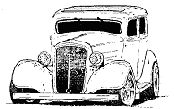The Ultimate Dual-Purpose Hot Rod
The Story of the Orange Crate
By Calvin Mauldin
Photography: The Rod & Custom Archives
As any rodder knows, a '32 Ford of any body style never gets thrown away. Short of being run over by a freight train, a Deuce will just keep coming back in one configuration or another. Owners may change, engines may be swapped, but once this ever-popular Ford model has been hot rodded, it stays that way.
Such was the case when Portland, Oregon's Bob Tindle bought a solid, albeit modified, '32 sedan in 1959, and over a period of five short years, dazzled the difficult-to-impress car-show faction as well as magazine editors. Bob's '32 came complete with such rodder's touches as a radical chopped top, a gutted interior, and rear fenders that had been bobbed and molded in for that mean and hungry look that could intimidate the competition just by standing still. Bob's younger brother, Terry, remembers what his brother purchased. "Man, that was a long time ago," he says, "but I remember the body was in excellent shape and covered in light-gray primer. It had a real hot flathead bolted in, but the guys Bob bought the car from wanted to keep that engine. Dave Bell had built a heated late-model Olds engine with six carburetors and put it in his '57 Corvette, and that engine would really run. Bob bought the Olds and had it put in the '32. We ran a Cadillac/LaSalle transmission with Second and High gears. I'll never forget sitting at the starting line, ready to go. The whole car shook, and really took off when the flag dropped."
Keith Randol kept the '32 tuned to a razor's edge for drag racing so the Tindles made a good showing at the strip, but Bob wanted to get more into the car-show side of the hobby. As Terry tells the story, "The car was painted lemon-yellow. It looked nice when it was entered in the Portland Roadster Show in 1960, and it did well. Then Bob decided to create an all-out show car. Keith Randol had just started up a shop, and Bob took the '32 there for a drastic rebuild. I should mention that Keith was a machinist, and years later went to Indy with a rear-engined racecar owned by Rolla Vollstedt. This was a short time before all the teams made the big move to rear-engine cars. Keith was a real pioneer. I don't know if Bob intended to go all-out with the sedan, but he would dream up an idea and Keith would take that idea a step or two further, making the '32 very innovative and far ahead of what was being built at the time."
The reconstructed show 'n' go Tudor turned out to be a quarter-mile, straight-line competition sedan riding on a Sprint Car-style chassis. The chassis itself was almost jewel-like in construction, having been fabbed from 3-inch-diameter, 0.120-inch wall seamless Shelby tubing, bent at curvaceous angles by Randol with a torch and tube bender. Adjustable suspension was added, along with a complete front axle assembly and Halibrand quick-change setup pulled from a 20-year-old Sprint Car that also gave up its Halibrand wheels. Obviously, Randol was honing his skills for future forays on circle tracks, but the blending of the two styles gave Bob's '32 an unquestionable "Wanna race?" attitude.
Dick Maris rebuilt the Olds with meticulous attention to detail. Case in point: After hours of porting and polishing the heads, the combustion chambers were slicked up and given a final polish with jeweler's rouge.
Enlarged to 417.63 ci, the mill was equipped with Hilborn injectors, using a front-mounted Potvin blower. A B&M Hydro trans capably handled the 600-plus horses that Marris concocted with the trademark wham/bang shifts.
The chassis/engine package was treated to a liberal dose of chrome plating and polishing, which made it a shame to cover it up with the body and hood panels. Therefore, Bob gave Randol another engineering puzzle: make the all-steel body tilt for display. Keith, the wizard machinist, went through the body, adding anti-flex support members. It was a strain on the average muscleman to raise the body, but the extra grunts and groans were worth it when the eye-popping engineering was revealed.
What the completed showpiece chassis needed was an equally exquisite body, and Von's Body Shop was assigned the task of getting the panels straighter than Henry ever made them. Reproduction fiberglass Ford parts maker Dee Westcott was given the job of building the top insert. When the metal was deemed worthy to paint, Von's covered the panels in Naples Orange (minus the peel), and thusly, the tart, tangy Orange Crate was officially born.
The fresh Orange Crate blitzed the '61 Winternationals, handily took the America's Best Competition Car trophy at the '61 Oakland Roadster Show, and graced the Feb. '62 issue of Hot Rod magazine. This was quite an accomplishment for the Orange Crate Gang from Portland, Oregon, considering that at the time, California was considered the leader of the pack when it came to hot rods.
For the 1962 show-business encore, the Orange Crate was treated to some additional, point-gathering details (as if it needed any more). It also competed once again at the Winternationals before Bob sent the wild, trophy-winning sedan on a whirlwind tour of car shows throughout the U.S. Afterward, Revell sent an engineer to Bob's high-performance automobile dealership, where the Orange Crate was diligently measured inch-by-inch for a model-car kit that would become a solid seller.
In 1963, the hot rod celebrity made what was to be its final showing at the Oakland Roadster Show, once again winning the coveted America's Best Competition Car trophy. Then, the Orange Crate was retired from show business and touring to a space at Bob's hot-car emporium. The details of the story after that become vague.
As Terry says, "One possible thing that led to the Orange Crate being retired was the fact that we opened a Chrysler/Plymouth store that year. That took up a lot of extra time." Being a competitive dealer also meant there was less time to keep the Orange Crate in tip-top show condition.
Terry continues, "In 1964, I bought my own Chrysler/Plymouth store in McMinville, Oregon, and moved there. I sort of lost track of what Bob was doing with the Orange Crate, and by 1965, he'd sold the '32 to a couple of guys he knew who were in the used-car business. That's really the last time I saw the Orange Crate, though people still ask me about it. That's how famous that car was, and still is."
Could the decision to sell have been a response to a gentle nudge from officials at Mopar? After all, here was a famous Oldsmobile-powered Ford sedan on a lot where stock Chryslers and Plymouths were being touted as the latest Michigan giant-killers. No one will ever know.
Over the years, the Orange Crate could be seen occasionally, whizzing by on the custom trailer Keith Randol built for it, or on hand at a used-car auction or swap meet, each time its once-dazzling appearance a bit more tarnished. Terry states that Bob looked at the sedan a few times, but never expressed any interest in buying the Orange Crate back for old times' sake. Besides, nostalgia drag racing hadn't been born yet, and few of us were very nostalgic about anything in the early '70s. An old competition sedan was virtually useless. Shortly after, the Orange Crate disappeared.
Over the last two and a half decades, rumors have abounded about the whereabouts of the Orange Crate. Paul Duchene, an enterprising writer for the Chicago Tribune, recently found the missing Crate. It's alive, if not too pristine, and living in rural Washington, owned since 1975 by drag racer Ted Gord. Gord knows what he has, as well as what needs to be done to get the old warrior back in show condition. He plans to build a shop for just that purpose and have the venerable sedan ready by the end of this year. Wouldn't it be a stupendous comeback if Gord took the Orange Crate back to the Oakland Roadster Show just one more time?
Sadly, Bob Tindle wouldn't be there, as he passed away recently, but we're sure Terry could be coaxed into coming to Oakland. He might even sign a few Revell Orange Crate kits (recently re-released from Revell-Monogram) for old fans that remember the unforgettable '32 from the early '60s or for new fans taking their first look at this resurrected classic.
|
|
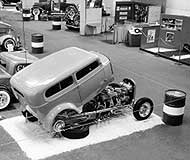
Here’s the Orange Crate in an early showing at the ’61 Winternationals indoor car show.
|
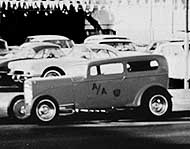
This shot is of the Crate in front of owner Bob Tindle’s car dealership in late 1963/early 1964, shortly before he sold it.
|
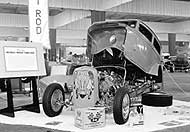
Although the general form of the Orange Crate remained constant for most of its career, it did go through minor changes during the four to five years that it competed regularly in shows. Here, we see the Crate at the Portland Roadster Show in 1962. The artwork in the grille insert depicts an actual orange crate with flaming zoomies and slicks, but in an odd, reversed perspective, with tire smoke clouding the “Orange Crate” banner.
|
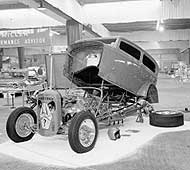
This is the car at the same show a year later, sporting an updated grille insert with more attractive graphics. The end of the cartoon crate reads, “Oregon Oranges.”
|

The Orange Crate proudly displays its healthy Olds mill, which had been punched out to 417 inches and fitted with a front-mounted Potvin supercharger and Hilborn injectors. The question marks on the zoomie covers matched similar markings on the intake covers and the grille insert, taunting onlookers to guess at just how tough it actually would be on the strip.
|
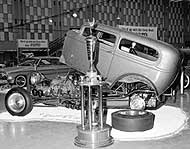
Tex Smith grabbed this shot at the Seattle Roadster show in the winter of 1963. The mammoth trophy came from the Oakland show, and was reportedly displayed at Bob Tindle’s dealership when the car wasn’t on tour. Bob’s brother, Terry, claims to still have it.
|
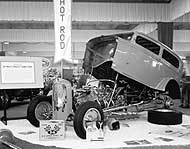
|

|

|
|



